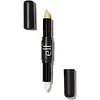What's inside
What's inside
 Key Ingredients
Key Ingredients

 Benefits
Benefits

 Concerns
Concerns

 Ingredients Side-by-side
Ingredients Side-by-side

Hydrogenated Polyisobutene
EmollientHydrogenated Polydecene
EmollientPolybutene
Bis-Behenyl/Isostearyl/Phytosteryl Dimer Dilinoleyl Dimer Dilinoleate
EmollientCaprylic/Capric Triglyceride
MaskingMicrocrystalline Wax
Emulsion StabilisingTheobroma Grandiflorum Seed Butter
Skin ConditioningEthylhexyl Palmitate
EmollientOlea Europaea Fruit Oil
MaskingOryza Sativa Bran Extract
Skin ConditioningHelianthus Annuus Extract
EmollientPortulaca Pilosa Extract
Skin ConditioningRosmarinus Officinalis Leaf Extract
AntimicrobialZingiber Officinale Root Oil
MaskingCetearyl Ethylhexanoate
EmollientGlycine Soja Oil
EmollientSodium Hyaluronate
HumectantPalmitoyl Tripeptide-38
Skin ConditioningEthylene/Propylene/Styrene Copolymer
Mentha Piperita Oil
MaskingSorbitan Isostearate
EmulsifyingTocopheryl Acetate
AntioxidantCapsicum Frutescens Fruit Extract
Skin ConditioningSilica Dimethyl Silylate
EmollientButylene/Ethylene/Styrene Copolymer
Tocopherol
AntioxidantSucrose Cocoate
EmulsifyingMethyl Nicotinate
SoothingPentaerythrityl Tetra-Di-T-Butyl Hydroxyhydrocinnamate
AntioxidantWater
Skin ConditioningButylene Glycol
HumectantPentylene Glycol
Skin ConditioningAlcohol
AntimicrobialLimonene
PerfumingEthylhexylglycerin
Skin ConditioningCaprylyl Glycol
EmollientCI 73360
Cosmetic ColorantCI 19140
Cosmetic ColorantCI 77891
Cosmetic ColorantIron Oxides
CI 15850
Cosmetic ColorantHydrogenated Polyisobutene, Hydrogenated Polydecene, Polybutene, Bis-Behenyl/Isostearyl/Phytosteryl Dimer Dilinoleyl Dimer Dilinoleate, Caprylic/Capric Triglyceride, Microcrystalline Wax, Theobroma Grandiflorum Seed Butter, Ethylhexyl Palmitate, Olea Europaea Fruit Oil, Oryza Sativa Bran Extract, Helianthus Annuus Extract, Portulaca Pilosa Extract, Rosmarinus Officinalis Leaf Extract, Zingiber Officinale Root Oil, Cetearyl Ethylhexanoate, Glycine Soja Oil, Sodium Hyaluronate, Palmitoyl Tripeptide-38, Ethylene/Propylene/Styrene Copolymer, Mentha Piperita Oil, Sorbitan Isostearate, Tocopheryl Acetate, Capsicum Frutescens Fruit Extract, Silica Dimethyl Silylate, Butylene/Ethylene/Styrene Copolymer, Tocopherol, Sucrose Cocoate, Methyl Nicotinate, Pentaerythrityl Tetra-Di-T-Butyl Hydroxyhydrocinnamate, Water, Butylene Glycol, Pentylene Glycol, Alcohol, Limonene, Ethylhexylglycerin, Caprylyl Glycol, CI 73360, CI 19140, CI 77891, Iron Oxides, CI 15850
 Reviews
Reviews

Alternatives
Ingredients Explained
These ingredients are found in both products.
Ingredients higher up in an ingredient list are typically present in a larger amount.
Ci 77891 is a white pigment from Titanium dioxide. It is naturally found in minerals such as rutile and ilmenite.
It's main function is to add a white color to cosmetics. It can also be mixed with other colors to create different shades.
Ci 77891 is commonly found in sunscreens due to its ability to block UV rays.
Learn more about CI 77891Ethylhexyl Palmitate, also known as octyl palmitate, is created from 2-ethylhexyl alcohol and palmitic acid. It is a fatty acid ester.
The fatty acid content of Ethylhexyl Palmitate makes it an emollient. Emollients help soften and hydrate your skin by trapping moisture within.
Ethylhexyl Palmitate is also used to help improve the texture of cosmetics. It helps other ingredient dissolve in products and help disperse ingredients more evenly.
You'll likely find this ingredient in sunscreen, as it is often used to mix UV-blocking ingredients such as avobenzone and ethylhexyl triazone.
It can also help stabilize the fragrances in a product as a fragrance fixative.
Ethylhexyl Palmitate can be used to substitute mineral oil.
Due to its high fatty acid content, it may not be fungal-acne safe.
Learn more about Ethylhexyl PalmitateMicrocrystalline Wax is created by de-oiling petroleum. It is highly refined and purified before being added to cosmetics.
Microcrystalline Wax is used to enhance the texture and create even consistency. It helps stabilize a product by preventing ingredients from separating.
This ingredient is a combination of red, black, and yellow iron oxide pigments. This combination of colors is usually found in foundation, because it results in a "skin" color.